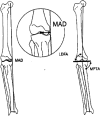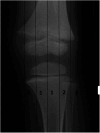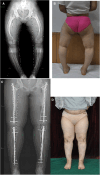Multi-segment osteotomy with interlocking intramedullary nail fixation in the treatment of lower limb deformity in older children with hypophosphatemic rickets
- PMID: 38440186
- PMCID: PMC10909947
- DOI: 10.3389/fped.2024.1332531
Multi-segment osteotomy with interlocking intramedullary nail fixation in the treatment of lower limb deformity in older children with hypophosphatemic rickets
Abstract
Objective: Malformations of the lower limbs caused by hypophosphatemic rickets in older children are mostly complex, occurring on multiple planes without a single apex and showing arcuate bending of the diaphysis combined with torsion deformity, and are difficult to correct. This study retrospectively investigated the effect of and indicators for multi-segment osteotomy with interlocking intramedullary nail fixation in the treatment of bony deformity caused by hypophosphatemic rickets.
Methods: The clinical data of 21 hypophosphatemic rickets patients seen between August 2007 and March 2022 were collected. The age range of the patients at the first surgery was 11 years and 1 month old to 15 years and 3 months old, with an average age of 12 years and 8 months. There were 6 males and 15 females. All patients had abnormal alignment of their lower limbs, with 32 limbs having varus deformity and 10 limbs having valgus deformity.
Results: A total of 67 surgeries were performed across the 21 patients, including 24 cases of femoral osteotomy with antegrade intramedullary nail fixation, 6 cases of femoral osteotomy with retrograde intramedullary nail fixation, and 20 cases of tibial osteotomy with interlocking intramedullary nail fixation. A total of 34 limbs eventually underwent interlocking intramedullary nail fixation, 9 with genu valgum and 25 with genu varus. All 21 patients were followed up for a period of 14∼96 months, with an average of 42.6 months. The ends of the osteotomies achieved bony union in 4-9 months (average 6.8 months), after which normal weight-bearing walking could be resumed. No infection, vascular or neurological complications, or nonunion occurred. During postoperative follow-up, the alignment the lower limbs passed through zone 1 in 13 limbs, zone 2 in 12 limbs, and zone 3 in 5 limbs. The overall rate of an excellent effect was 83.3%.
Conclusion: For lower limb deformity caused by hypophosphatemic rickets in older children, multi-segment osteotomy and strong fixation with interlocking intramedullary nails can achieve good correction outcomes.
Keywords: hypophosphatemic rickets; interlocking intramedullary nail; lower limb deformity; older children; osteotomy.
© 2024 Lu, You and Wang.
Conflict of interest statement
The authors declare that the research was conducted in the absence of any commercial or financial relationships that could be construed as a potential conflict of interest.
Figures




Similar articles
-
Results of deformity correction in children with X-linked hereditary hypophosphatemic rickets by external fixation or combined technique.Int Orthop. 2015 Dec;39(12):2423-31. doi: 10.1007/s00264-015-2814-7. Epub 2015 Jul 7. Int Orthop. 2015. PMID: 26150332
-
Acute Correction of Multiplanar Proximal Tibial Deformity Utilizing Fixator-Assisted Intramedullary Nailing.JBJS Essent Surg Tech. 2022 Aug 31;12(3):e21.00045. doi: 10.2106/JBJS.ST.21.00045. eCollection 2022 Jul-Sep. JBJS Essent Surg Tech. 2022. PMID: 36816522 Free PMC article.
-
Deformity correction by external fixation and/or intramedullary nailing in hypophosphatemic rickets.Acta Orthop. 2006 Apr;77(2):307-14. doi: 10.1080/17453670610046073. Acta Orthop. 2006. PMID: 16752295
-
An Approach to Intraoperatively Identify the Coronal Plane Deformities of the Distal Tibia When Treating Tibial Fractures with Intramedullary Nail Fixation: a Retrospective Study.Orthop Surg. 2022 Feb;14(2):365-373. doi: 10.1111/os.13194. Epub 2021 Dec 28. Orthop Surg. 2022. PMID: 34964267 Free PMC article.
-
Lower limb inequality treatment with subtrochanteric femoral shortening osteotomy fixed with intramedullary nail.Pol Orthop Traumatol. 2012 Sep 18;77:65-71. Pol Orthop Traumatol. 2012. PMID: 23306289
Cited by
-
Surgical treatment of the varus knee caused by vitamin D-resistant rickets. Report of two cases and review of the literature.Int J Surg Case Rep. 2025 Apr;129:111187. doi: 10.1016/j.ijscr.2025.111187. Epub 2025 Mar 24. Int J Surg Case Rep. 2025. PMID: 40139138 Free PMC article.
References
-
- Albright FB, Butler AM, Bloomberg E. Rickets resistant to vitamin D therapy. Am J Dis Child. (1937) 54(3):529–47. 10.1001/archpedi.1937.01980030073005 - DOI
LinkOut - more resources
Full Text Sources
Miscellaneous

